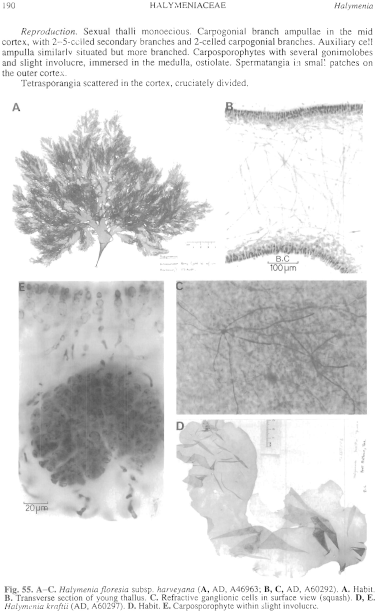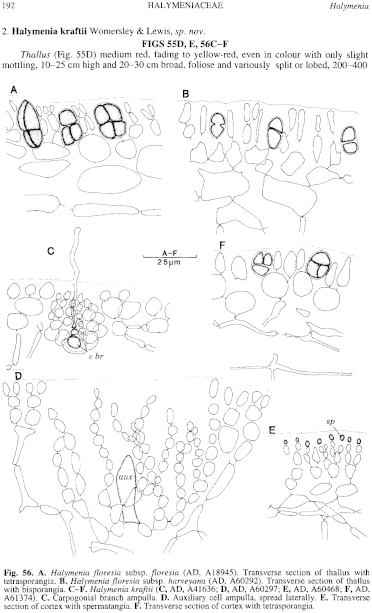|
|
|
|
|
|||||||||||
|
Electronic Flora of South Australia Species Fact Sheet
Phylum Rhodophyta – Class Florideophyceae – Order Gigartinales – Family Halymeniaceae
Thallus (Fig. 55D) medium red, fading to yellow-red, even in colour with only slight mottling, 10–25 cm high and 20–30 cm broad, foliose and variously split or lobed, 200–400
(–600) µm thick, margin smooth to irregular; stipe 0.5–1 cm long, cuneate above and usually spreading fairly rapidly to the broad frond. Holdfast discoid, 1–4 mm across; epilithic or on mollusc shells. Structure (Fig. 55E) of a cortex 2–4 cells thick, outer cells 4–6 (–10) µm in diameter, isodiametric to slightly elongate, with small, scattered groups of surface hairs, inner cells ovoid to subspherical, 12–18 µm across, with stellate cells (not becoming refractive and ganglionic) internal to the cortex, and a lax medulla of mostly transverse filaments. Rhodoplasts one to a few per cell, ribbon shaped, branched.
Reproduction: Probably dioecious. Carpogonial branch ampullae (Fig. 56C) small, situated in the inner cortex, with a few short secondary filaments of subspherical cells and a 2-celled carpogonial branch. Auxiliary cell ampullae (Fig. 56D) with 10–12 relatively long secondary and tertiary filaments of ovoid cells, converging above and reaching almost to the outer cortex. Carposporophytes (Fig. 55E) lying within the medulla, 120–200 µm across, carposporangia more or less isodiametric, (4–) 6–10 µm across, auxiliary cell present at base; involucre slight, formed from ampullary filaments which branch further near their apices, leaving a slight ostiole. Spermatangia (Fig. 56E) cut off from outer cortical cells, 2–3 µm in diameter, with subspherical spermatia 1–2 µm in diameter.
Tetrasporangia (Fig. 56F) scattered in the outer cortex, ovoid, 13–22 µm long and 8–14 µm in diameter, cruciately divided.
Type from Port Arthur, Tas., 18 m deep (AIMS-NCI Q66C 3836-L, 1.iii.1990); holotype in AD, A60297.
Selected specimens: Port Arthur, Tas., 10–12 m deep (McCauley, 2.iii.1990; AD, A60468). SW of Sloping I., Frederick Henry Bay, Tas., 10 m deep (AIMS-NCI, Q66C 5023-Z, 12.ii.1991; AD, A61374). 2 km N of Satellite I., D'Entrecasteaux Ch., Tas., 12 m deep (Shepherd, 17.ii.1972; AD, A41636). Tinderbox, D'Entrecasteaux Ch., Tas. (Huisman, 13.ii.1991; MELU, A38665). Off Simpson Bay, Bruny I., Tas., 11 m deep (Shepherd, 11.ii.1972; AD, A41597). Jervis Bay, N.S.W., 16 m deep on shells 1 km W of Bindijine Beach jetty (Millar & Richards, 2.vi.1990; NSW, A9512) and 45 m deep off "hole in the wall" (Millar & Richards, 7.iii.1990; NSW, A8957).
Distribution: SE Tasmania and Jervis Bay, N.S.W.
Taxonomic notes: H. kraftii is based on a specimen with abundant auxiliary cell ampullae and carposporophytes. Specimen A41636 has abundant carpogonial branch ampullae with subspherical cells, at first appearing specifically distinct from the auxiliary cell ampullae of the type, but linked by occasional intermediates. A60468 (male) and A61374 (tetrasporic) are similar in form to the type specimen.
H. kraftii differs from other foliose species of Halymenia in the relatively simple ampullae, especially those with carpogonial branches. It is named in honour of Dr G.T. Kraft.
References: The Marine Benthic Flora of Southern Australia Part IIIA
Publication:
Womersley, H.B.S. (14 January, 1994)
The Marine Benthic Flora of Southern Australia
Rhodophyta. Part IIIA, Bangiophyceae and Florideophyceae (to Gigartinales)
Reproduced with permission from The Marine Benthic Flora of Southern Australia Part IIIA 1994, by H.B.S. Womersley. Australian Biological Resources Study, Canberra. Copyright Commonwealth of Australia.
Illustrations in Womersley Part IIIA, 1994: FIGS 55D, E, 56 C–F.

Figure 55 enlarge
Fig. 55. A–C. Halymenia floresia subsp. harveyana (A, AD, A46963; B, C, AD, A60292). A. Habit. B. Transverse section of young thallus. C. Refractive ganglionic cells in surface view (squash). D, E. Halymenia kraftii (AD, A60297). D. Habit. E. Carposporophyte within slight involucre.

Figure 56 enlarge
Fig. 56. A. Halymenia floresia subsp. floresia (AD, A18945). Transverse section of thallus with tetrasporangia. B. Halymenia floresia subsp. harveyana (AD, A60292). Transverse section of thallus with bisporangia. C–F. Halymenia kraftii (C, AD, A41636; D, AD, A60297; E, AD, A60468; F, AD, A61374). C. Carpogonial branch ampulla. D. Auxiliary cell ampulla, spread laterally. E. Transverse section of cortex with spermatangia. F. Transverse section of cortex with tetrasporangia.

|
Email Contact: State Herbarium of South Australia |

|